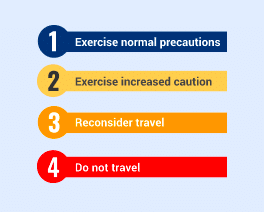On 6 December 2021, the United States imposed level 4 travel advisories against Cyprus, France, Liechtenstein, and Portugal, bringing the number of level 4 travel advisories against Schengen and EU Member States to a total of 26, or nearly every Member State of the two agreement areas.
The countries that the US has listed the level 4 advisory against are:
- Austria
- Belgium
- Bulgaria
- Cyprus
- The Czech Republic
- Denmark
- Estonia
- France
- Hungary
- Germany
- Greece
- Iceland
- Ireland
- Italy
- Latvia
- Liechtenstein
- Luxembourg
- Montenegro
- The Netherlands
- Norway
- Poland
- Portugal
- Romania
- Slovakia
- Slovenia
- Switzerland
Level 4 travel advisories come from the US Department of State and list a specific country as one to which US nationals should not travel to for any reason.
In this case the risk of travelling cited is risk of contracting or spreading Covid-19, and the Department of State is referring to the US Centers for Disease Control and Prevention (CDC) level 4 health advisories.
Some of the countries listed above, such as Italy, have been listed as a level 4 threat since 16 June 2021, meaning that the old travel advisories from 2020 were essentially just amended for those countries.
What a level 4 travel advisory means is not that US nationals are forbidden from going to the country listed, but rather that the US government is strongly discouraging travel to any of the countries listed above, assuming that those countries will allow travelers in to begin with.
Because the US is Europe’s top long-haul travel market, this presents a huge problem for the continent’s economy as well as ties to the US economically, socially, and diplomatically. This is because while most Americans will take the travel advisories into account and ultimately make their own decision, many Americans will still base their decisions on the governmental warnings.
Before the pandemic, travel and tourism accounted for 10% of the EU’s total gross domestic product (GDP) which is used as a measure of economic health and activity. The industry also provided jobs and sources of wellbeing for 26 million Europeans.
The US’s travel advisories have dramatically hurt the European travel and tourism sector as well as the larger economy.
In addition, the US’s travel ban on Europe, which bans essentially all Europeans from entering the country has further strained back-and-forth travel.
Combined with European countries’ own travel bans against outsiders, which are nearly always confusing, complicated and uncoordinated, there has been much discouragement about travelling from either the US to Europe or from Europe to the US.
What this means is that despite the World Health Organization’s guidance on travel bans even the most developed Western countries are still sticking to these measures, further threatening the livelihoods of millions, and destroying the larger global economy.
Schengen-Visa.com is committed to bringing the most accurate news and updates about the situation with Covid-19, travelling, and getting a Schengen Visa from anywhere in the world.
To see the US State Department’s full list of travel advisories, click this link.
To read the WHO’s guidance on travel bans and how they are not effective, click this link.









